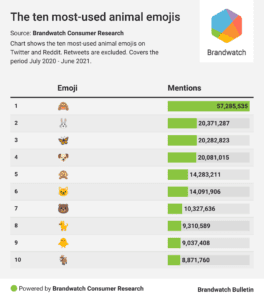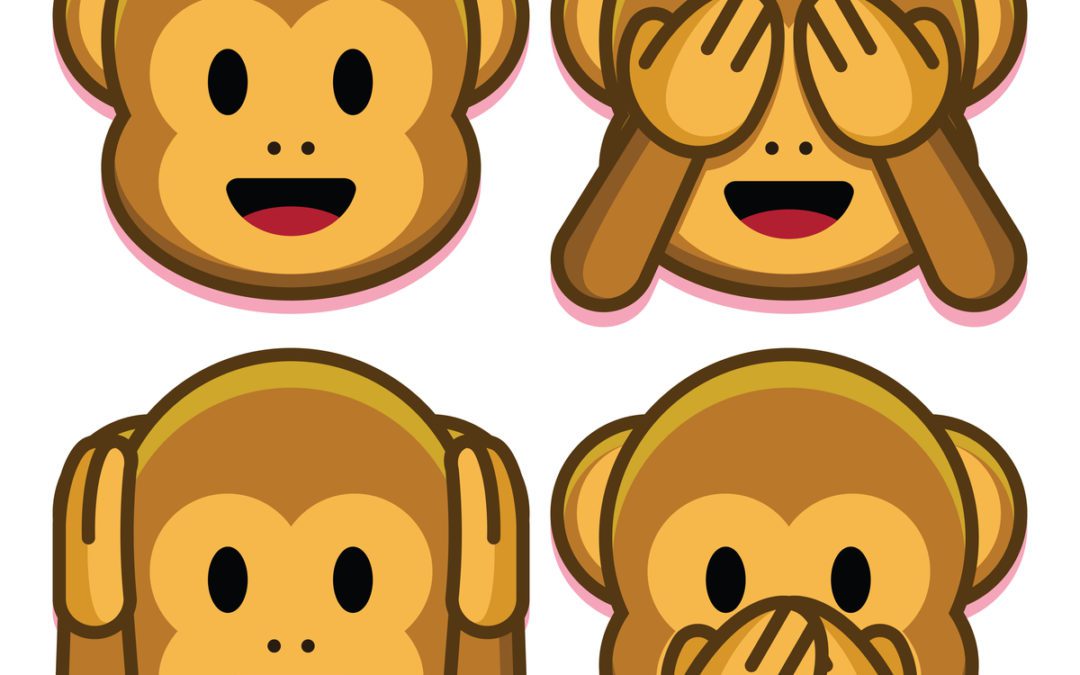We hope you had a great weekend. Now it’s time to start your week with the most important topic out there: animal emojis 🙂
Brandwatch has analysed emoji usage a lot over the years, and today we’re adding to this esteemed body of emoji work with an analysis of animal emojis, including how often they’re used, the most-popular ones, and how usage differs by country.
To start, let’s take a look at volume. There was a sharp uptick in animal emoji use in March 2020, presumably due to the onset of the pandemic and general social media use going up. This growth has continued ever since and if we compare the first six months of 2021 to the same period in 2019, we can see use is up 117%.

Some of these are easily explained. People love cats and dogs (numbers 6 and 4) and they’re common pets, so it’s no surprise they’ve made the top ten. Others have gained new meanings beyond the one originally intended.
The See-No-Evil Monkey at Number 1 on the chart, comes from the ‘three wise monkeys’, but is now mainly used in to express laughter, disbelief, and cringing. Similarly, the Speak-No-Evil Monkey (number 5) is used in reference to keeping secrets and saying unexpected or shocking things.
Note: Monkey emojis in general have also been in the news recently, associated with racist abuse. You can read more on that here.
As with most topics online globally, K-pop band BTS and their fans are influencing things. Each member has an associated emoji, with Jungkook’s being the Rabbit Face, something which likely helped it take second place. Other emojis on the list associated with band members are the Mouse Face (Seokjin), and Front-Facing Baby Chick (Jimin).
You’ll also notice the Goat emoji sneaking in at number ten. As you might have guessed, that’s often used in conjunction with the acronym GOAT: greatest of all time.
In terms of the differences by country, when it comes to animal emojis way, way, way out in front is Japan. As the birthplace of emojis, it’s no shock they’re top, but the volume is something to behold. Their number means between July 2020 and June 2021, 57k animal emojis were posted for every 100k people living in Japan. In comparison, the US saw just 7k.
And the popularity of different emojis also varies by country. You can see the full chart here.
Japan again stands out, this time for failing to be as enamored with the See-No-Evil Money as the others (although it still takes 4th place). It’s also the only country to get the Cat, Penguin, Fish, and Panda emojis into its top ten. Some other unique appearances are the UK’s Bee, making their top ten due to its association with the city of Manchester, and the Brits’ general fondness of the insects. The US, of course, has the Eagle, an emoji version of their national symbol. Meanwhile Brazil has the Dove in its top ten, often used in a Christian context, and South Korea has the Tiger Face which is another BTS-related one (the emoji is assigned to Taehyung).
It can be easy to be flippant about emojis, but they can tell us a lot in the ways they are used. Just as slang does, they can offer insight into the culture and interests of the people who use them. They’re always worth a thought.

